Annular Eclipse 2012
Who Shrunk the Moon?
| Main
Page |
Eclipse
Page |
Annular Eclipse 2012Who Shrunk the Moon? |
This was my 10th Eclipse, but first annular. After seeing many eclipses in the past I have developed a rough idea of what they should look like before totality is reached. By about 1/2 way between C1 (where the moon first touches the sun) and C2 (where the moon hides the sun) it was clear that something was very different this time. The moon was too small. It was not going to cover the sun.
An annular eclipse is a different experience than a total eclipse. From the standpoint of imaging it is much simpler. You leave the solar filters on during the entire event. There are only a couple of different exposures needed. No high dynamic range of brilliant prominences and ethereal corona. In this case you are imaging the surface of the sun the whole time. The proper exposure varied from about 1/500 at the start to about 1/200 during annularity.
Unlike a total eclipse the sky did not dim significantly. Even at maximum there was plenty of sun left. The air did cool about 10 degrees F, but was that the eclipse or the time of day?
For this eclipse the moon was close to its apogee (the furthest point from the earth). Consequently its apparent size was the smallest I have seen.
Click on any of the pictures for a
larger view
I shot 200 exposures during the event under computer control. This
was a trick I learned in Libya. This
allows the computer to do the work during the event leaving me free to
enjoy. My polar alignment was good enough that a tweak at C2 minus 1
minute was good enough. Since there would be no corona this time the
sun's image would be easily kept in frame. Pixinsight fixed all of the
misalignments after I got home.
Between C1→C2 and C3→C4 I shot a sequence of 3 exposures on a 3 minute delay. Starting about 1 minute before C2 I changed to using a delay of about 10 seconds. This large number of pictures meant that I did not have to micromanage the exposure during the event. It will also give me plenty of data for the movie.
All Times are in UTC. For fast conversion 0000 UTC is 5 PM PDT.
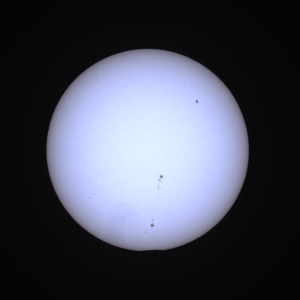 |
Right on time at about 16 minutes past 5 PM PDT the first notch of
sun was gone. Look at the 6 o'clock position of the sun. |
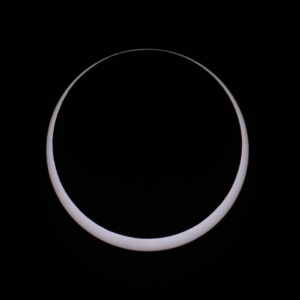 |
About 4 minutes after the start of annularity the moon slid to the
other side of the sun. This shot taken a couple of seconds
before C3 shows the moon about to exit the disk of the sun. |
When the moon crossed the edge of the sun there as an instant where only
the sun passing through the valleys on the edge showed through. In a
total eclipse these would appear as Bailey's Beads and mark the end of
totality. Since in this eclipse the solar filters were on the entire
time the bead effect was muted. I did see bead's at C3, but they only
lasted a second and my shots were not timed to catch them.
I looked at about 6 different sites when deciding where to attempt this
eclipse (Shasta Lake, Lassen NP, Pyramid Lake, Fernley WR, Stillwater NWR,
and a spot along route 50.
Jay Anderson's weather predictions indicated that the Redding, CA area had the best chance with a surprising (to me) dip at the Fallon NAS. However, from my own experience I was concerned about finding a good horizon in the California sites. I was originally going to set up at Pyramid Lake, but the Lake's proximity to the Sierras and a local festival discouraged me from there. Of the three remaining sites Stillwater was the most inviting having a real parking lot (and toilets). The weather for Fallon NAS was the only concern. I decided that distance from the Sierras with a reasonable drive from Reno (where I spent the night) were the primary concerns.
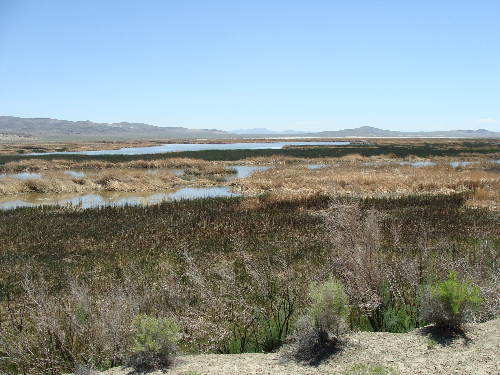 |
The wildlife refuge is in an area known as the Carson sink. Unlike the Reno area, the area around the nearby town of Fallon is relatively lush. |

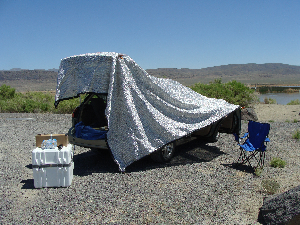 |
The wait was really quite pleasant. We got to the site early about 1 PM. Since temps were forecast into the 90s I knew that plenty of water and a cool place out of the sun were going to be important. I brought some Aluminet that I used for camping at regional star parties. That provides a cool spot to hide from the sun and wait. There was even a pit toilet just to the right out the field of view. Unfortunately it did not save us from the relentless dear flies. Well I was warned to bring spray (and we did). |
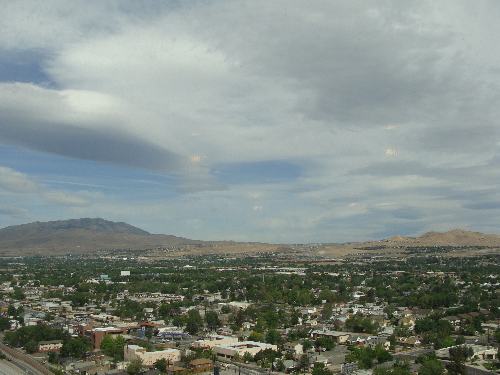 |
This is what greeted us the next morning at our hotel in
Sparks. Not the first time that the good weather window closed
dramatically after the eclipse was over. |
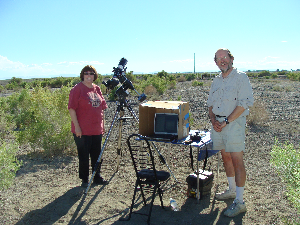 |
In many respects the equipment for this trip was a clone of the 2006 Libya trip. Since I
traveled to this site by car (instead of plane,ship, and bus) I got
a more comfortable setup with a table and viewing chair. Also
I was using a 12V car battery for power so I had plenty of 'triz. Note no eye patch. Since there was no totality this time there was no reason to dark adapt. One more simplification of this event. |
After proving Computer control in Libya and missing it during the Easter
Island event, it was a no brainer that I would use it again. And after all
this time I did not need the permission of the Department of Commerce to
take my laptop to the site☺.
I have used a Canon 20Da ever since 2006. This is a standard camera
that has a number of modifications for astrophotography including higher
sensitivity to H-alpha. It can be fully controlled using a USB
cable. Since I was using solar filters the entire time the H-alpha
sensitivity was not important.
For a telescope I chose a TeleVue 76. This is a relatively small APO
and it mates well with the 20Da. The combination yielded an effective
focal length of 768 mm at f/ 6.3.
The tracking mount was an Orion SkyView Pro. This is a heavier mount
than I used in Libya and Easter Island, but again using the car was a
benefit. We were expecting winds at the end of the day and I knew
this mount would be more stable
The capture scenario this time was pretty basic. A loop of 3
exposures that I hoped would bracket the correct exposure. As it
turned out I needed a slower shutter speed during annularity, but I was
only off by one or two speed settings. Adding some curve correction
fixed everything.
My wife was also watching but used a projection viewer that I built using
an old finder and a box. The image from the finder projected onto a piece
of white paper in the box. The image was bright, but watchable and
it was safer than my use of binoculars with filters taped to them.
Copyright 2012 Robert J. Hawley, Some Rights Reserved

All photos and text concerning the Annular Eclipse 2012 were taken by
Robert J. Hawley
and are licensed under a Creative
Commons
Attribution-Noncommercial-Share Alike 3.0 United States License.
This permits the non commercial use of the material on this site, either
in whole or in part, in other works provided that I am credited for the
work.
I have also granted a commercial license for some of the images.